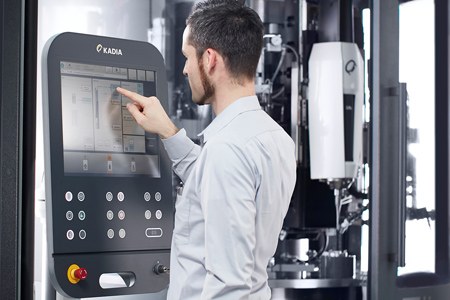
With the HMC100 machine controller, the operator gets the most out of the LH honing spindles.
Every micrometer counts when it comes to honing high-precision components, such as those required for injection systems or hydraulic applications. In order to meet these high quality requirements, honing machine manufacturer KADIA Produktion GmbH + Co. uses direct drive technology for the spindles and the stroke. The company has released the second generation of its Lean-Highspeed (LH) honing spindles.
The first LH honing spindles with direct drives for rotation and stroke were presented by KADIA in 2004. "Direct drive technology is unbeatable in terms of smooth operation and precise control. Its use in the small to medium diameter range - this is our specialty - has led to a leap in productivity and quality, which is rarely the case with new developments nowadays," said Henning Klein, Managing Director at KADIA.
The direct drive, used for the first time for the stroke movement via linear motor, offers optimally adapted drive and performance, both of which are requirements for high material removal rates. Moreover, the linear motor works contact-free, basically wear-free and transfers practically no vibrations to the honing tool. "In contrast, conventional honing stroke systems rely on components that are subject to wear, such as ball bearing spindles," said a company spokesperson. "The deceleration and acceleration in the reversal points of the oscillation quickly impose limits to the constantly high precision. Similar advantages are also featured by the spindle drive, a directly driven synchronous built-in motor. The low-maintenance motor spindle provides high torque without causing the tool to vibrate. The tool expansion takes place electromechanically by means of a high-resolution servomotor with precision screw drive. On the honing stones, feed is possible down to the nano range."
KADIA has combined all of these high-tech individual components in one compact unit. The spindle motor and expansion motor are arranged coaxially one above the other and in the immediate vicinity of the linear drive. The directly initiated expansion movement of this arrangement increases the rigidity of the entire system.
The inner coolant supply provides optimal process cooling. "Due to our LH honing spindles, even demanding high-precision applications, such as match honing with clearance tolerances of <1 µm, can be safely implemented," said Klein. In nearly 10 years, more than 700 high-tech spindles of the first generation have been supplied, in five variants. They perform reliably in a wide range of single- and multi-spindle machines.
Ten years ago, constructors would have excluded the possibility of achieving a more compact design. "However, parts, components and applications have continued to develop, so it was time to adapt the concept to the current state of technology," said Klein. For example, there was room for improvement in terms of inner coolant supply, and this enabled a shorter design and more comfortable accessibility for maintenance purposes. The tool clamping also showed a potential for optimization: the customized hydraulic expansion chuck is now seated directly in the honing spindle and no longer on the spindle tip. This not only has an impact on the construction length, but also leads to precise radial spindle runout.
"The most important improvement was made to the overall design of the individual drives in regards to performance, size and weight, so every honing spindle now has the best possible configuration," said the spokesperson. "Another benefit is that the number of initially five variants has been reduced to two, with the designations LH2 and LH3 - however, several variants are possible for the stroke and different standard lengths are available. Despite the smaller size and weight reduction of almost 30%, LH2 achieves the same forces and torques as the previous KADIA standard spindle. The larger LH3 lies in the range of the formerly most powerful predecessor model at nearly 20% less weight."
"Due to the even more compact design, dynamic range and chip removal capacity have increased further. The power consumption is now lower at the same time - a major advantage," said Klein. "The new generation offers efficiency, including the possibility of feeding electricity back into the grid. To give just one example: The power consumption of an LH2 spindle during a typical honing process is 0.0025 kWh/workpiece. Another aspect is important to the users: KADIA offers a five-year warranty on the linear stroke drive. This represents an above-average value, which indicates high levels of reliability."
A leading manufacturer of fuel injection pumps deploys the KADIA T line honing machine, equipped with five LH spindles, which is responsible for the key process: final processing of high pressure bores. Because of the narrow tolerances of a few microns, the components are match honed. For that, the previously manufactured pistons are measured in several measuring planes; the measurement results serve as target dimensions for the honing machine. "The process flow is stored in the machine control system and is thus highly automated, so handling costs are reduced towards zero. The new LH2 shows what it can accomplish in this challenging application - match honing is said to be the supreme honing discipline. The geometrical precision of the bore has improved by 5-10% and the matching clearance tolerance by 50%," said Klein. "In his overall evaluation, the user confirms a process quality increase of 25% - a giant leap forward."
The LH honing units offer the greatest benefit in conjunction with the HMC100 high-performance machine controller, also developed by KADIA. HMC100 represents the latest honing processes and measuring methods. The complex processes are translated into a simple presentation on a 19" panel. This enables intuitive machine operation, even when it comes to sophisticated processes.
For more information contact:
KADIA Inc.
8070 Kensington Ct.
Brighton, MI 48116
248-446-1970
info@kadiausa.com
www.kadiausa.com